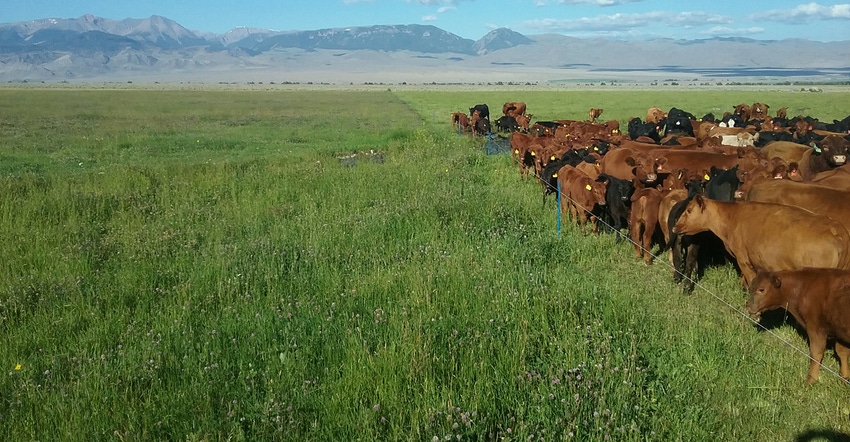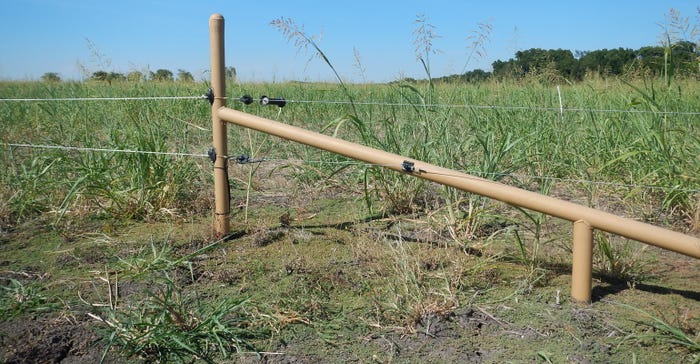September 22, 2020

The secret to profitable cattle raising is your grazing plan. A focused approach to using the grass you have can help boost your stocking rates, enhance pounds per acre and put more money in your pocket.
To boost grazing output, you may be looking at pasture condition, grass and feed types available, but there’s one factor you don’t want to leave out — the fences.
The fencing system is the backbone of a grazing plan. Well-planned fencing and water sources facilitate rotating livestock to improve forage utilization. Fixed, permanently fenced grazing cells and flexible grazing cells, with temporary fencing, can be used to rotate livestock for an adaptive grazing management plan.
To get a more in-depth look at both fixed and flexible grazing cell approaches we turned to an expert — Jim Gerrish, a nationally known grazing consultant — to get insight on the finer points of fencing and grazing.
Maximize fixed-cell approach
Fixed grazing cells consist of permanent fencing and water sources. This minimizes daily labor and maintenance. “Depending on the size of the fixed cell,” says Gerrish, “you might just open the gate and call the cattle to you and through the gate to rotate cells. And that’s the daily labor.”
 TOUGH FENCE: A high-tension perimeter fence can be a valuable tool as part of a holistic managed grazing program. Getting the right tension and wire heights can make a difference.
TOUGH FENCE: A high-tension perimeter fence can be a valuable tool as part of a holistic managed grazing program. Getting the right tension and wire heights can make a difference.

Permanent fencing, with high-quality materials installed correctly, requires minimal maintenance. There are many options for permanent fencing, though. One popular type is high-tensile wire. On Gerrish’s ranch in Idaho’s Pahsimeroi Valley, the original perimeter fence around the center pivots consisted of 170,000-PSI (pound-force per square inch) high-tensile wire. He installed fixed fencing of 200,000 PSI to subdivide the pivot circles.
“The elk regularly break the 170,000-PSI fences,” Gerrish says. “It is a much inferior wire. In the last 16 years, elk haven’t broken any of the 200,000 PSI. Absolutely use high-quality wire when building permanent fences.”
For sheep, space three high-tensile wires from the ground at 8 inches, 16 inches and 28 inches. The 28-inch-high fence works fine for cattle, too. “If a cow or yearling crosses a 28-inch-high fence, I consider that culling criteria,” Gerrish says. “You can’t have one or two recalcitrant animals dictate the fence policy for the entire ranch.”
For cattle-only fencing, Gerrish sets a bottom wire at 18 or-20 inches, and the top wire at 30 to 32 inches. A large elk herd lives on Gerrish’s ranch. The low-profile, 30- to 32-inch fence creates space for elk to hop over it without damage, because it’s low on their center of gravity.
“Additionally, the combination of 200,000-PSI high-tensile wire and flexible-line posts — like the wood-plastic composite PasturePro post or Timeless Fence poly T-post — minimize the elk impact on the fence,” Gerrish explains.
Antelope also roam Gerrish’s ranch. “I was told for a long time that antelope don’t jump fences,” Gerrish says. “But I see them routinely scoot under and hop over our fences that have the bottom wire at 18 to 20 inches and the top wire at 30 to 32 inches.”
 THE RIGHT REEL: Grazing authority Jim Gerrish has specific recommendations for the gear reel you use with poly-wire for flexible fencing. This makes it easier to pull in the wire when making a change.
THE RIGHT REEL: Grazing authority Jim Gerrish has specific recommendations for the gear reel you use with poly-wire for flexible fencing. This makes it easier to pull in the wire when making a change.

Fixed grazing cells are most economical for expansive operations, because permanent infrastructure costs can be spread over more acres. It’s the increased animal production per acre that pays for infrastructure investment, Gerrish advises. “Recently, I consulted on an 8,000-acre ranch in the Nebraska Sandhills to design fixed grazing cells,” he explains. “For water, nine-and-a-half miles of pipeline and 15 stock tanks. Nearly 20 miles of new permanent fence. It cost $40 an acre.”
In contrast, Gerrish designed similar fixed grazing cells on a 540-acre ranch that cost $130 per acre. “If flexible grazing cells, instead of fixed cells, had been created there, I think the cost could have been $70 per acre for the small operation,” Gerrish says. “The rancher wanted fixed cells because he also works in town. His perception is that he doesn’t have the time to move temporary fencing.” With the right equipment and tools, Gerrish says the less expensive temporary fencing of flexible grazing cells can be moved efficiently.
Using a flexible grazing cell
The management flexibility, combined with the lower price tag attracts many to the flexible grazing-cell model. The framework of flexible grazing cells consists of perimeter permanent fence and some permanent water sources, with moveable stock tanks and temporary electric fences that subdivide an area into paddocks.
“There was a time in my life,” Gerrish recalls, “when I thought that the flexible design was only good for a couple hundred acres. Any operation bigger than that needed a fixed design. Now, I see thousands of acres managed as flexible grazing cells.”
Gerrish recommends braided poly-wire on geared reels for temporary fences. A reel geared at a 3-to-1 ratio cranks up a fence much faster than a straight crank reel. A 9-filament braided poly-wire holds increased conductivity, and a greater physical breaking strength, than a similar twisted poly-wire.

MAXIMIZE GRASS: Whether you use fixed-cell or flexible-cell grazing, a holistic approach to pasture management can help you raise stocking rates and put more money in your wallet.

Step-in posts are the quickest way to erect temporary fence. On Gerrish’s website, americangrazinglands.com, he sells the two step-in posts that he likes the best: O’Briens Treadaline and Gallagher Ring Top. “There are a lot of knockoff posts of the O’Brien, and none are as good as the true O’Brien that is stamped ‘Made in New Zealand,’” Gerrish says. “Most plastic posts only last three to five years, but I have O’Brien posts that are over 20 years old.�” The Gallagher Ring Top post is a steel-shank, step-in post.
“These two posts are usable in all ground conditions, because the post spike that goes into the ground is relatively small in diameter,” Gerrish explains. “The O’Brien post spike is a 3/16-inch-diameter, high-tensile rod. Most step-in posts have 5/16-inch or 3/8-inch spikes. The larger the diameter of a post spike, the more resistance it gives when you try to put it into the ground. I have used both of these posts in extreme conditions, from frozen ground to desert rock to clay pack.”
To effectively confine livestock, an electric fence requires a properly installed energizer. Place at least 3 feet of ground rod per joule of energizer output. For instance, a 6-joule energizer needs 18 feet of ground. Typically, this is created with 6-foot ground rods spaced 10 feet apart.
Energizer designs range across a spectrum of applications. One of Gerrish’s favorite characteristics is an energizer’s capability to operate on dual power. It can either be plugged into the mains or run from a battery, which can be configured to charge via a solar panel.
Gerrish’s other purchase criteria for an energizer is its ability for remote control. “With a remote-ready energizer, you can turn off the energizer anywhere out in the fence system,��” Gerrish explains. “You could be 10 miles from the energizer, find that the elk came through and broke some fence; [you] shut the energizer down from that point, make the repair and then switch it back on.”
These fencing equipment and tools efficiently move fencing and cattle to rotational grazing. “On our 300-acre center pivot, I daily move cattle and over 1,000 feet of fencing on that big pivot,” Gerrish explains. “It typically takes me 28 minutes to dismantle the fence and reset it. We generally run 400 to 500 cow-calf pairs there.” When considering temporary fencing, it pays to decrease the labor needed to move it when rotating livestock to fresh grass.
Whatever the size and needs of your ranch, an appropriate fence system can be developed to match your grazing management plan. Smartly designed grazing cells, with high-quality equipment and tools, will increase ranch profit by minimizing labor and increasing forage yield.
Hemken writes from Lander, Wyo.
About the Author(s)
You May Also Like




